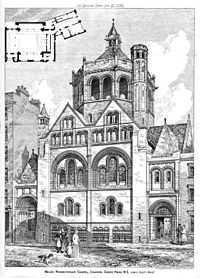James Cubitt

James Cubitt (1836–1912) was a Victorian church architect specialising in building non-conformist chapels.[1] He was the son of a Baptist minister, from Norfolk who taught at Spurgeon's Pastor's College in South Norwood Hill[2] — then on the outskirts of London.
Cubitt was articled to the firm of Isaac Charles Gilbert, in Nottingham (1851—56) and joined W. W. Pocock building chapels for the Wesleyans. From 1862, he formed his own office, forming a partnership with Henry Fuller in 1868.[2]
Cubitt's philosophy was laid out in his book, Church Design for Congregations. He attacked as obsolete the traditional nave and aisle design. When the "columns are thick or moderately thick, it inevitably shuts out a multitude of people from the service ... When, on the other hand, its columns are thin, the inconvenience is removed, but the architecture is ruined ... The type as it remains is but a shadow of its former self–a medieval church in the last stage of starvation". Too many architects were failing the principal criteria of their brief: "to produce a grand and beautiful church in which everyone could see and hear the service".[1]
His chapels are built as broad uncluttered spaces around a central pulpit and Lord's table.
Cubitt lived most of his professional life at Loughton, where he built several private houses and three schools. He is commemorated by a blue plaque on Monghyr Cottage, 2 Traps Hill, Loughton, where he died, and was buried in an unmarked grave next to his wife in Loughton Cemetery.
References
- ↑ 1.0 1.1 History of the Union Chapel accessed 7 June 2009
- ↑ 2.0 2.1 James Cubitt (1836-1912) (Archiseek) accessed 7 June 2009
- The Contexting of a chapel architect: James Cubitt 1836-1912 Clyde Binfield (The Chapels Society, 2001)
- The Buildings of Loughton and notable people of the town Chris Pond (Loughton and Dist Historical Society, 2nd ed, 2010)
Works
- Architecture
- Emmanuel Congregational Church in Cambridge (1873)
- Union Chapel, Islington (1877)
- Welsh Presbyterian Church Charing Cross Road (1888)
- Dulwich Grove United Reformed Church (formerly Congregational), East Dulwich London (1890)
- Staples Road Junior School, Loughton (1888)
- Sunnybank, nos 7-9 Woodbury Hill, Loughton, Essex (1889)
- Books
- Church Design for Congregations (1870)
See also
- Dissenting Gothic
- Cubitt - James Cubitt is no relation to his contemporary engineers and master builders of the same name.
|